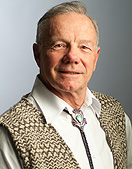News
Damage depends on preparation
Comparable natural disasters in different parts of the world can cause widely varying amounts of damage, Michael Sheridan, former director of the Center for Geohazards Studies, told his UBThisSummer lecture audience on Wednesday.
The level of death and destruction hinges on a community's level of preparation for earthquakes, landslides, volcanic eruptions and other hazardous events, said Sheridan, an internationally renowned volcanologist.
He pointed to two large earthquakes earlier this year to demonstrate his point. A magnitude 7 quake devastated Haiti in January, killing perhaps 300,000 people and leveling large swathes of the capital city, Port au Prince. In contrast, a much larger, magnitude 8.8 quake in Chile the following month took fewer than 1,000 lives.
What accounted for this difference?
“In Chile, they put the rebar in the buildings…That’s one way of reducing your risk,” Sheridan said, noting that in Haiti, many structures that collapsed were not built with proper reinforcement.
Other past emergencies also demonstrate the power of preparation. In 1972, a landslide in Hong Kong smashed tall buildings but did not result in casualties because the government had been monitoring the area and evacuated dwellings in the predicted path of the moving earth.
In Colombia, however, a lahar—a flowing mass of volcanic debris and water—killed 28,000 people after the volcano Nevado del Ruiz exploded. Residents could have fled to higher ground, but without adequate warning and education, the slide came as a surprise.
“It’s really tragic,” Sheridan said, “because they could have escaped very easily.”
Today, scientists like Sheridan try to understand geohazards by gauging their frequencies, mapping potential dangers, developing computer models to portray phenomena and collaborating with civil protection and scientific groups to implement prevention and response measures.
But researchers—along with policy makers—still have a lot to learn. One frequent mistake that planners make is to assume that worst-case scenarios, which require more complicated responses than lower-level disasters, will not occur.
Another problem: Governments sometimes fail to take into account the risk perceptions of locals. In some hazard-prone regions, relocating residents to safer places might not always be the best alternative, Sheridan said. The amount of risk people are willing to take varies by culture. Inhabitants of a danger zone might see the land they occupy as sacred, and leaving, for them, might not be an option.
That is the scenario Sheridan encountered when he met with villagers living in the shadow of Colombia’s most dangerous volcano, Galeras. Any disaster plan must consider the psychology of native populations as an important factor, he said.
“Of course, they could be safer if they evacuated, but their culture would be destroyed almost certainly if they left,” he said. “So for them, the biggest risk was leaving their home, and that made me think, ‘Maybe that’s true for all of us.’ We all have a different level of evaluating the risk, depending on the situation.”


Reader Comments